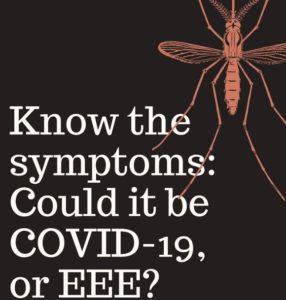 HYANNIS – The summer of 2020 on the Cape & Islands is one that arrived with a drastically different feel due to the coronavirus pandemic.
HYANNIS – The summer of 2020 on the Cape & Islands is one that arrived with a drastically different feel due to the coronavirus pandemic.
And after being inside for months, many are feeling more comfortable returning to what is being called “the new normal” which encourages outdoor seating at restaurants and enjoying socially-distant outdoor gatherings.
While it may be not only safer, but recommended to get back outside and enjoy the open air, there’s a second virus to consider: Eastern Equine Encephalitis Virus (EEE), that is not spread through contact with another human, but instead is spread through mosquitoes. For neither virus is there a cure-and both can be fatal.
Sound familiar? It should. “As we all remember, 2019 was a particularly challenging year for Eastern Equine Encephalitis. The 2019 season was notable for both the large number of human and animal cases and the widespread nature of the activity.
There were 12 human cases with at least 6 deaths – the highest number of cases in a single year since 1956,” reminds Dr. Catherine Brown, Massachusetts State Epidemiologst.
“Because EEE activity usually occurs over a 2-3 year period in Massachusetts, we are expecting and planning to respond to another difficult season this year. Although it is impossible to predict the severity of the season in advance, the presence of EEE virus last year, the relatively mild winter and the wet spring all suggest that EEE will occur this year.”
Experts say their main concerns not only lie with how many will contract either virus. There is also concern that since the appropriate response for each virus differs, yet their symptoms are similar, mistaking EEE for Covid-19 can be dangerous.
In addition, in both viruses, some that become infected can be asymptomatic while still being carriers.
Here’s what’s similar and different in each virus.
How soon after contracting the disease will symptoms show?
Per the CDC’s website, ‘The incubation period for Eastern equine encephalitis virus (EEEV) disease (the time from infected mosquito bite to onset of illness) ranges from 4 to 10 days.’
For Covid-19, symptoms can appear anywhere from 2-14 days after exposure.
What are the symptoms?
For EEE symptoms include fever, chills, malaise (general feeling of discomfort/fatigue), arthralgia (joint pain), and myalgia (muscle pain), headache, vomiting, diarrhea, seizures, behavioral changes, and coma. Per the CDC’s website, “The type of illness will depend on the age of the person and other host factors.”
For Covid-19, symptoms include fever or chills, cough, shortness of breath or difficulty breathing, fatigue, muscle or body aches, headache, new loss of taste or smell, sore throat, congestion or runny nose, nausea or vomiting, or diarrhea.
How long do symptoms last, and how serious are they?
There’s far more information on EEE since it has been around longer. According to the CDC website, illness can last 1 to 2 weeks, and most people recover completely when there is no central nervous system involvement.
However, approximately a third those who contract EEE die usually within 2 to 10 days after showing symptoms, although death can still occur much later. On their website, the CDC warns that “of those who recover, many are left with physical or mental sequelae, which can range from mild brain dysfunction to severe intellectual impairment, personality disorders, seizures, paralysis, and cranial nerve dysfunction. Many patients with severe sequelae require long-term care and die within a few years.
EEE infection can result in a systemic febrile illness or neurologic disease, including meningitis (infection of the membranes that surround the brain and spinal cord) or encephalitis (infection of the brain).” In infants, neurologic disease often occurs soon after onset; in older children and adults, encephalitis may occur after several days of systemic illness.”
For Covid-19, symptoms have been reported all across the board from being mild to severe, some simply feeling as if they had a bad cold and others slipping into a coma and needing a ventilator for 40+ days or more. In the most severe cases, death can occur within the first week or after a prolonged period of time.
“By the time you make the diagnosis, and the test is positive 7 days later, the person has already had neurological damage that is not fixable. And the treatment is just supportive care- ventilator, (life) support, preventing seizures, etc.,” explains Dr. Lisa Nagy from Environmental Health Center of Martha’s Vineyard.“Compared to Coronavirus, you spike faster and have higher fever and it progresses very quickly with neurologic damage.
There is no stroke from EEE, but we’ve seen strokes in corona. There are no lung clots with EEE, but with Coronavirus we’ve seen those.” The concern, Dr. Nagy says, is knowing that COVID-19 seems to affect everyone differently and at times, COVID can act just as quickly as EEE in different ways.
“One person got corona and died within 2-3 days from kidney failure. If you have patients in your society walking around who are already kind of sick, they also are fatigued patients who might have going to have a low adrenal function and they’re more likely to go into shock and die with any infections.”
So, what can we do to prevent getting either virus and where are we with vaccines?
While the Department of Defense did release a statement that they are actively working on a vaccine. For EEE, there are vaccines for horses already out there, but one has not yet been created for humans. “Dr. Fauci said last year that it is not yet of major national importance, so there were not enough cases to care, it seems,” says Dr. Nagy before referencing a recent article that did say one was in production as of last year due to the recent spike.
Since there is no treatment available for EEE or COVID-19 that has been proven, the best thing to do is no secret: stay inside. Yet medical professionals understand that’s not always possible-or healthy- to always be indoors, and there are ways to stay safe and get outside and a mask won’t protect you from getting EEE. “The most important prevention tools are the steps we can all take to protect ourselves and our families – using mosquito repellent, using clothing to keep mosquitoes from getting to your bare skin, and rescheduling outdoor activity to avoid the hours between dusk and dawn in the locations and seasons of highest risk,” cautions Dr. Brown.
“Aerial spraying is one tool in the tool box to help reduce risk from EEE but it does not eliminate the problem. DPH uses surveillance to identify areas of high and critical risk and works with mosquito control experts and the State Reclamation and Mosquito Control Board to determine what control actions are indicated.”
By Emmalyn Reid, Cape Wide News























